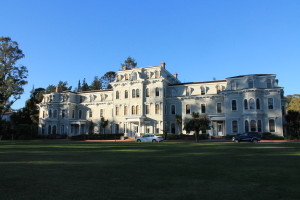
I walk into Good Vibrations on Polk Street in San Francisco on a Sunday afternoon. I pass the lingerie, penis-shaped lollipops, dildos and harnesses, until I find what I came for. The Antique Vibrator Museum, a “hidden sexual treasure” as the sex store’s website calls it, contains vibrators and “women’s personal massagers” from the late 1800s through the 1970s. In addition, there are newspaper and magazine ads, as well as other insinuating “massage” artifacts on display.
Joani Blank (1937-2016), fed up with the silence surrounding women’s sexuality and the lack of access women had to sex information and toys, opened the doors of the first Good Vibrations in the Mission District of San Francisco in 1977. It was the second sex shop in the entire country that was specifically geared toward women. Blank set out to normalize the act of shopping openly for sexual and erotic items, by making her store a friendly, clean and well-lit alternative to the seedy “Adult” stores splashed across America. The store was a hit, and it has now grown to be a worker-owned organization with eight retail stores (seven in the Bay Area), an online sex-shop, and an erotic-movie producer.
Blank’s commitment to educating and promoting a sex-positive environment for women to buy sex toys and other sexual aids is revolutionary, even in today’s more sex-positive culture. The frankness and intimacy of women-focused sex stores such as Good Vibrations is a welcome ally in the ongoing fight for a woman’s own control over her body and the way it naturally functions.
The Antique Vibrator Museum is a quirky trip for people who find the history of sex and sex aids interesting. The earliest known vibrator was a steam-powered massager from 1869, used by medical-professionals to treat “female disorders,” including hysteria. “Hysteria” was a medical term used to describe women’s display of mental or emotional distress. It was treated by bringing on “hysterical paroxysm,” or what we know today as an orgasm. Doctors would manually bring about an orgasm to relieve the patient of her “condition,” a practice that was ultimately replaced with “at home” treatments.

I walked around the store, hoping to be able to chat with one of the employees. There were several customers in the store–mostly couples, but a few solo shoppers like myself. The expressions on their faces ranged from slightly awkward to serious contemplation of which style of harness would be better suited to their partner’s persona. I overheard the conversation between the punk-pixie femme employee and the business-casual Caucasian couple, just enough to gather that they were interested in learning more about pegging. I rifled through lingerie hoping to find something within my budget, contemplated buying a porn-feature for $5 just for the fun of it and finally asked a sales associate for more information on the museum.
Kate, the sales associate, brought me to the back to give me an informal guide to the museum. She spoke with an air of excitement, relaying to me the history of the vibrators, the history of Good Vibrations, as well as adding similar information she had researched on her own time. She pointed out her personal favorite, a “one-of-a-kind” homemade vibrator, which included a pot handle and parts from a lawn mower in its construction. When I asked her about what it was like to work for Good Vibrations, she paused.
“[It is] definitely different than just working at Target…you have to have an interest, you have to have empathy because people come in here wanting answers on things they are too shy to talk to anyone else about,” she said. “You have to in order to be comfortable and open about sex, which I am all about personally.”
The antique vibrator museum is opened daily from 12:30 p.m. to 6:30 p.m. The museum is easily accessible by public transportation, and is located in a beautiful area well suited for a lazy Sunday stroll.


